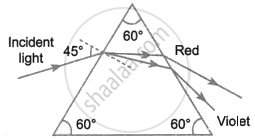Advertisements
Advertisements
Question
A ray of light is incident at 45° on an equilateral prism in the diagram below.

- Name the phenomenon exhibited by the ray of light when it enters and emerges out of the prism.
- State the cause of the above phenomenon mentioned by you.
Solution
- When light enters the prism and experiences refraction upon exiting, it is said to have undergone dispersion.
- It disperses because the incident light is a polychromatic ray made up of different light wave lengths. As light travels from a denser medium to a rarer medium, refraction takes place.
APPEARS IN
RELATED QUESTIONS
What is spectrum? What is the name of glass shape used to produce a spectrum?
In the following diagram, the correctly marked angles are
(A) All
(B) Only ∠i and ∠A
(C) ∠i, ∠r and ∠A
(D) ∠i, ∠A and ∠D
Make the correct choice for each of the following:
Which one of the following Fig correctly shows the path of the ray through the glass block?
The wavelength range of white light is ______.
The phenomenon of splitting of light into its component colours is ___________ .
A student has to trace the path of a ray of light through a glass prism. List four precautions he should observe for better results.
Write the range of wavelength of the visible spectrum.
The splitting of white light in to seven colors is called ______.
In dispersion, the color of light that will bend more is ______.
The angle of deviation through a prism is minimum when

- Incident rays and emergent rays are symmetric to the prism.
- The refracted ray inside the prism becomes parallel to its base.
- The angle of incidence is equal to that of the angle of emergence.
- When the angle of emergence has doubled the angle of incidence.
Choose the correct answer from the options given below:
